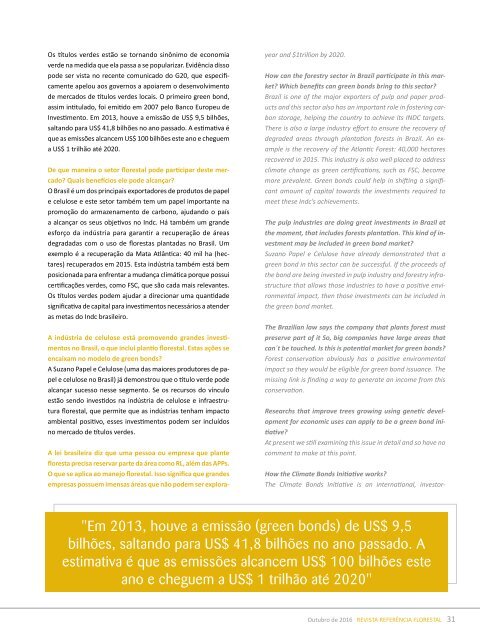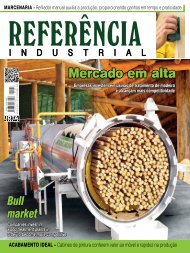Outubro/2016 - Referência Florestal 179
Visitantes - Grupo Jota Comunicação
Visitantes - Grupo Jota Comunicação
You also want an ePaper? Increase the reach of your titles
YUMPU automatically turns print PDFs into web optimized ePapers that Google loves.
Os títulos verdes estão se tornando sinônimo de economia<br />
verde na medida que ela passa a se popularizar. Evidência disso<br />
pode ser vista no recente comunicado do G20, que especificamente<br />
apelou aos governos a apoiarem o desenvolvimento<br />
de mercados de títulos verdes locais. O primeiro green bond,<br />
assim intitulado, foi emitido em 2007 pelo Banco Europeu de<br />
Investimento. Em 2013, houve a emissão de US$ 9,5 bilhões,<br />
saltando para US$ 41,8 bilhões no ano passado. A estimativa é<br />
que as emissões alcancem US$ 100 bilhões este ano e cheguem<br />
a US$ 1 trilhão até 2020.<br />
De que maneira o setor florestal pode participar deste mercado?<br />
Quais benefícios ele pode alcançar?<br />
O Brasil é um dos principais exportadores de produtos de papel<br />
e celulose e este setor também tem um papel importante na<br />
promoção do armazenamento de carbono, ajudando o país<br />
a alcançar os seus objetivos no Indc. Há também um grande<br />
esforço da indústria para garantir a recuperação de áreas<br />
degradadas com o uso de florestas plantadas no Brasil. Um<br />
exemplo é a recuperação da Mata Atlântica: 40 mil ha (hectares)<br />
recuperados em 2015. Esta indústria também está bem<br />
posicionada para enfrentar a mudança climática porque possui<br />
certificações verdes, como FSC, que são cada mais relevantes.<br />
Os títulos verdes podem ajudar a direcionar uma quantidade<br />
significativa de capital para investimentos necessários a atender<br />
as metas do Indc brasileiro.<br />
A indústria de celulose está promovendo grandes investimentos<br />
no Brasil, o que inclui plantio florestal. Estas ações se<br />
encaixam no modelo de green bonds?<br />
A Suzano Papel e Celulose (uma das maiores produtores de papel<br />
e celulose no Brasil) já demonstrou que o título verde pode<br />
alcançar sucesso nesse segmento. Se os recursos do vínculo<br />
estão sendo investidos na indústria de celulose e infraestrutura<br />
florestal, que permite que as indústrias tenham impacto<br />
ambiental positivo, esses investimentos podem ser incluídos<br />
no mercado de títulos verdes.<br />
A lei brasileira diz que uma pessoa ou empresa que plante<br />
floresta precisa reservar parte da área como RL, além das APPs.<br />
O que se aplica ao manejo florestal. Isso significa que grandes<br />
empresas possuem imensas áreas que não podem ser explora-<br />
year and $1trillion by 2020.<br />
How can the forestry sector in Brazil participate in this market?<br />
Which benefits can green bonds bring to this sector?<br />
Brazil is one of the major exporters of pulp and paper products<br />
and this sector also has an important role in fostering carbon<br />
storage, helping the country to achieve its INDC targets.<br />
There is also a large industry effort to ensure the recovery of<br />
degraded areas through plantation forests in Brazil. An example<br />
is the recovery of the Atlantic Forest: 40,000 hectares<br />
recovered in 2015. This industry is also well placed to address<br />
climate change as green certifications, such as FSC, become<br />
more prevalent. Green bonds could help in shifting a significant<br />
amount of capital towards the investments required to<br />
meet these Indc’s achievements.<br />
The pulp industries are doing great investments in Brazil at<br />
the moment, that includes forests plantation. This kind of investment<br />
may be included in green bond market?<br />
Suzano Papel e Celulose have already demonstrated that a<br />
green bond in this sector can be successful. If the proceeds of<br />
the bond are being invested in pulp industry and forestry infrastructure<br />
that allows those industries to have a positive environmental<br />
impact, then those investments can be included in<br />
the green bond market.<br />
The Brazilian law says the company that plants forest must<br />
preserve part of it So, big companies have large areas that<br />
can´t be touched. Is this is potential market for green bonds?<br />
Forest conservation obviously has a positive environmental<br />
impact so they would be eligible for green bond issuance. The<br />
missing link is finding a way to generate an income from this<br />
conservation.<br />
Researchs that improve trees growing using genetic development<br />
for economic uses can apply to be a green bond initiative?<br />
At present we still examining this issue in detail and so have no<br />
comment to make at this point.<br />
How the Climate Bonds Initiative works?<br />
The Climate Bonds Initiative is an international, investor-<br />
"Em 2013, houve a emissão (green bonds) de US$ 9,5<br />
bilhões, saltando para US$ 41,8 bilhões no ano passado. A<br />
estimativa é que as emissões alcancem US$ 100 bilhões este<br />
ano e cheguem a US$ 1 trilhão até 2020"<br />
<strong>Outubro</strong> de <strong>2016</strong> REVISTA REFERÊNCIA FLORESTAL<br />
31

















